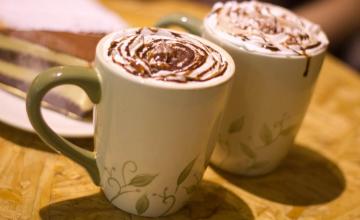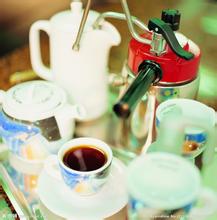Sunny Ye Jia Xue Fei Flavor Description Taste Characteristics Manor Name Introduction
Sun Yega Chuefei flavor description taste characteristics manor name production area introduction
Yejassefi's coffee trees were planted by European monks (a bit like Belgian monks growing wheat to brew beer) and were later transferred to farmers or cooperatives. Yejia Chuefei is actually constructed by surrounding coffee communities or cooperatives, including Edido Idido, Hafusa Harfusa, Hama Hama and Biloya near Fog Valley Misty valley, all washed with water, but there are also a small number of off-product beans engraved with sun to enhance the charming fruit aroma and mellow thickness. These mountain villages are foggy, like spring all year round, with a gentle breeze in summer, cool but not hot, rain but not damp, and no cold damage in winter, giving birth to a unique regional flavor of citrus and flowers. Coffee trees are mostly planted in farmers' own backyard or mixed with other crops in the field, the yield per household is not much, it is a typical rural coffee. Yega Xuefei won the prize beans almost from the above-mentioned coffee villages and communities.
The so-called "Yega Chuefei" refers to the strong aromas of jasmine, lemon or lime acid, as well as peach, almond or tea. On the other hand, the smell of dried blueberries is particularly prominent this season, and the room is full of blueberries after grinding.
Yirga cheffe is a small town in Ethiopia, 1700-2100 meters above sea level, and it is also synonymous with Ethiopian boutique coffee. Since ancient times, it is a wetland. The ancient saying "Yega" yirga means "settle down", and "Xuefei" cheffe means "wetland". Therefore, Yejasuefi means "Let's settle down in this wetland".
Strictly speaking, Yega Xuefei is a by-product area of Ethiopia's Sidamo Sidamo province, located northwest of Sidamo, along the mountain with paste, is one of the highest coffee-producing areas in Ethiopia. However, the mode of production and flavor here are so outstanding that Ethiopian coffee farmers compete to be proud of the flavor of their coffee, so they are independent from Sidamo and become the most famous producing area in Africa.
Sun-treated Erika G1 has more lively citrus citric acid, aromas of apricot blossoms, exploding nuts of walnuts, and subtle aromas of cinnamon, cloves, rosemary and other spices. taste with a very good honey brown sugar sweet, very soft and attractive, as if the whole body soaked in the sea in early autumn, slapped by the cool sea Full of impact and stretching tenderness. What is even better is the tail rhyme, which will be filled with a sweet and sour sense of fruit and tea, like colorful bubbles. In such a reverie, Maoye seems to have returned to the era of first love, the era of carefree efforts to love.
Many people must want to know the difference between the Ariga G1 and the Blue Nile G1. Master Cat, let's briefly introduce the two Yega Xuefei. The biggest difference is that Ariga G1 belongs to the sun treatment, while the Blue Nile G1 belongs to the washing treatment. As we all know, Yejia Xuefei is actually more common to use the traditional washing method to show her beautiful taste. Yega Xuefei treated with water washing has a clean and light taste, with a very strong aroma of jasmine and citrus citric acid. In the ancient saying, Yirga means "settle down", while Cheffe refers to "wetland". From such place names, it can be seen that Yega Xuefei is one of the areas with the highest water content in Ethiopia, so most of the coffee produced in Yega Xuefei is washed. Yega, on the other hand, is relatively rare, and it has gradually come to the fore with the diversified development of boutique coffee in recent years. This sun-treated Yeruifei Ariga G1 means that it will have more ripe fruit flavor than water-washed beans, sweeter floral aromas and stronger layers.

Important Notice :
前街咖啡 FrontStreet Coffee has moved to new addredd:
FrontStreet Coffee Address: 315,Donghua East Road,GuangZhou
Tel:020 38364473
- Prev

Introduction to the method of describing the Flavor of G _ 1 Coffee beans washed with Kochere
Yega Xuefei Kochere washed G1 coffee beans flavor description treatment method variety introduction of ripe beans, this is more obvious, the sun G3 white beans are very many, it can be concluded that there are more immature beans in raw beans, coffee fruit harvest is very extensive, mature and immature coffee fruits are mixed together. While the cooked beans in the G1 sun are very uniform, the white beans are almost negligible, and the farmers pick them.
- Next

Ethiopian Sidamo Lion King Coffee Flavor description, Grinding characteristics, introduction to the taste of varieties in producing areas
Sidamo Coffee Bean introduction although a big-name store has made a rare boutique latte limited to how many cups, not 98, only 58. The children who know how to do it will laugh it off. But we still have a regular latte price, not unlimited supply, because the quantity of boutique coffee beans is limited! In fact, many boutique coffee shops in Shanghai already have those full of berries, honey and hazelnuts.
Related
- Detailed explanation of Jadeite planting Land in Panamanian Jadeite Manor introduction to the grading system of Jadeite competitive bidding, Red bid, Green bid and Rose Summer
- Story of Coffee planting in Brenka region of Costa Rica Stonehenge Manor anaerobic heavy honey treatment of flavor mouth
- What's on the barrel of Blue Mountain Coffee beans?
- Can American coffee also pull flowers? How to use hot American style to pull out a good-looking pattern?
- Can you make a cold extract with coffee beans? What is the right proportion for cold-extracted coffee formula?
- Indonesian PWN Gold Mandrine Coffee Origin Features Flavor How to Chong? Mandolin coffee is American.
- A brief introduction to the flavor characteristics of Brazilian yellow bourbon coffee beans
- What is the effect of different water quality on the flavor of cold-extracted coffee? What kind of water is best for brewing coffee?
- Why do you think of Rose Summer whenever you mention Panamanian coffee?
- Introduction to the characteristics of authentic blue mountain coffee bean producing areas? What is the CIB Coffee Authority in Jamaica?

